Do you back up data with cell phone?
Today, you always have a mobile phone at hand, with which you can call from anywhere and anytime. More recently, such an opportunity seemed unbelievable, and today mobile phones have become the central link in the communication between people. That is why you should think about synchronizing data on a PC and on a cell phone in time.
Current trends are as follows: in addition to reducing the size of modern cell phones, there are color displays with high resolution and unprecedented quality. Smartphones are becoming the equivalent of a PDA in terms of feature set. OS is responsible for the software side of the issue Microsoft Windows Mobile, but there are other operating systems, the same Series 60.
Phones acquire additional functions: mail client, chat, MP3-player, digital camera with video recording function or even a mobile TV. And lowering the price of flash memory only increases the attractiveness of new features.
But, as is the case with conventional computers, many users are in no hurry to reserve their data. Imagine what will happen to your phone book, organizer, calendar, photos or songs if you lose your phone or it is stolen? Therefore, the issue of data synchronization between a PC and a cell phone is becoming increasingly important.
To connect to a computer, cell phone owners can use a cable, infrared or Bluetooth. Although many cell phones use their own interfaces, there is still a trend today: the infrared ports are gradually disappearing, and the USB port is replacing them.
If your phone supports Bluetooth, then everything is much easier: Windows Service Pack 2 already has a Bluetooth stack, so no problems.
Cell Phone: Mobile Data Center
Today we use cell phones even more than stationary phones. "Mobile phones" have already firmly entered our lives. We always take the phone with us, use it to store the entire address book, and send SMS via it. And thanks to the proliferation of 3G (Third Generation) Wireless technology, in the future you can hope for mobile email and video. Life is developing so rapidly that now it is important not to miss anything. Even the fact that today you can always be in touch and communicate anywhere is impressive.
At the same time, many cell phones are getting entry-level digital cameras. Today, three megapixels in a cell phone will not surprise anyone. Unless the optical characteristics and the absence of optical zoom distinguish telephone cameras from "normal" ones. In the near future, cell phones are unlikely to replace digital cameras. But for some intermediate photos, “mobile” can still be used.
Cell phones have evolved into a mobile database. They take and store photos, play favorite songs, display a calendar and keep in memory all the communication data - email and SMS. On the one hand, a wide range of functions allows cell phones to be more versatile. On the other hand, our dependence on mobile phones is also increasing. What happens if you lose your phone?
Is your data safe?
Many modern cell phone models offer expansion slots for flash cards. You can install cards in the phone in formats RS-MMC, MMC Micro, Mini SD or Micro SD, with a capacity of 64 MB to 2 GB. With the help of a USB reader and adapter, all “small” formats can be turned into SD cards, that is, it is easy to read all the data on the computer.
It is through flash cards that it is easiest to back up data such as photos, video clips, SMS, letters emailmusic. However, data arrays such as calendar and address book are usually not written to flash cards. They are in internal memory phone. To transfer or synchronize a calendar or phone book, you need to establish a connection between the phone and the computer.
To do this, you can use a special USB cable, as well as Bluetooth. Typically, the cable is sold separately for about $ 20 or more. Bluetooth, in our opinion, is a more convenient solution, since this interface can also be used for other purposes.
Right-click on the Bluetooth icon. After that, select the "Add bluetooth device/ Add a Bluetooth Device ", which will add a new cell phone.
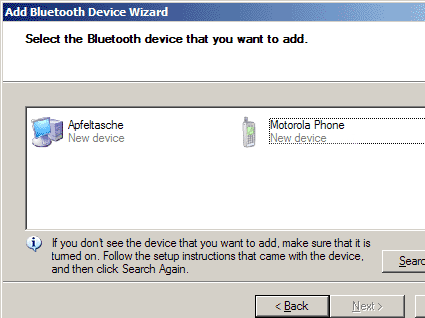
If the Bluetooth device is already in the list, then just select it. Otherwise, you have to conduct a search. In this case, the phone with Bluetooth must be included in the "visible" mode. First of all, do not forget to turn on the Bluetooth connection itself on the "mobile phone".
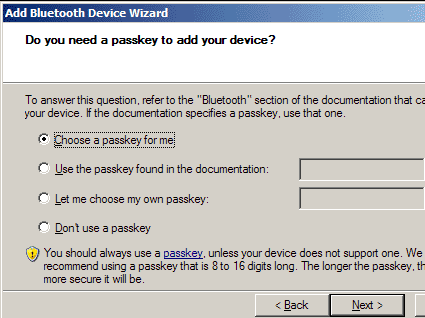
To ensure protection, only authorized devices can be connected. Here we create a new password key ...
![]()
... which should be entered on the "mobile phone". All is ready!
The option "Send a file" allows you to transfer the file to a Bluetooth device.
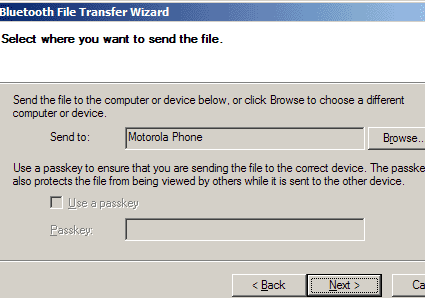
Select target device ...
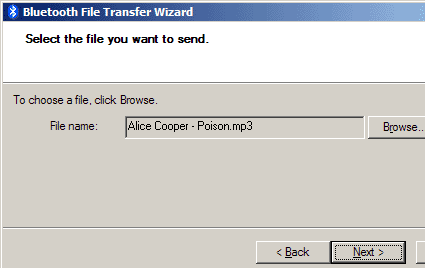
... and the transferred file.
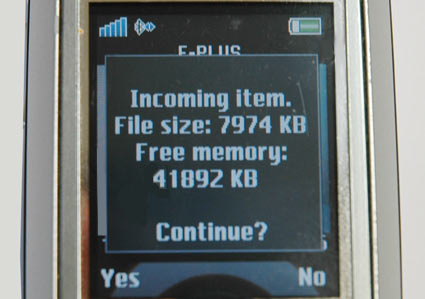
After starting the copy, you need to confirm the reception on your cell phone.
We recommend connecting an external Bluetooth adapter directly to your computer’s USB port. Experience shows that if you use a USB hub, you may experience side effects: the Bluetooth adapter may not be recognized, or you will have to reinstall the driver each time you connect.
Motorola cell phones use Mobile Phone Tools 4.0 to communicate with a PC. During her windows installation complained several times about drivers that are not WHQL certified. However, warnings can be ignored.
Despite all the fears, the Motorola program worked correctly. On the menu quick start The "Phone Tools" icon has appeared. And in the Outlook options menu, we found a sync key. But when we chose the Bluetooth connection, the phone simply “hung” for several tens of seconds. The problem was observed on the Compaq Evo N800v with several external Bluetooth adapters, as well as on the Toshiba Satellite 5200 with integrated Bluetooth.
It seems that the integration of Bluetooth in the phone RAZR V3 (i) is still too "raw", even if you use the Bluetooth control panel from Windows. When the user connects the phone to the computer, the phone will ask for a password. If you spend too much time typing, the connection will break. Even if the connection is established, the phone does not send a response signal for about half a minute. Other phones are more responsive.
Bad Bluetooth connection
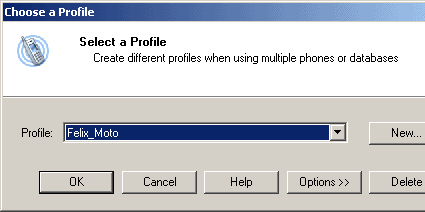
First, create a connection profile.
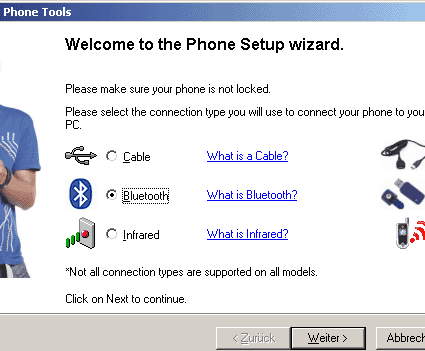
Then you should configure the type of connection. If you want to recharge the RAZR battery at the same time, it is better to choose USB.
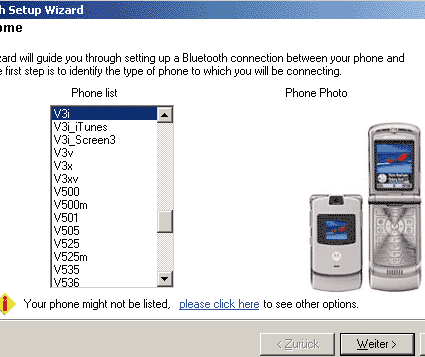
Finally, you should choose a phone.
Once the connection with the RAZR V3i is established, you can send or receive files with the right mouse button on the Bluetooth icon. V3i transfers large amounts of data very slowly. RAZR V3 with 5 MB of memory does not have such a problem. But the V3i is equipped with 12 MB of internal memory and a slot for flash cards (the bundle comes with a 64 MB Mini SD card). The program should definitely be modified so that it normally copes with the increased V3i memory.
V3i interrupted the transmission of an MS Word document (.doc), reporting an unknown file type. The phone refused to accept text files, although .vcf files (a business card with personal data), .wav or .mp3 were transferred without problems and were recorded in the corresponding directory.
Problems arose when we tried to transfer a file of about 6.8 MB in size. We got a file transfer status window, but nothing arrived on the phone. In addition, the connection speed was very slow. For example, it took us 6 minutes 31 seconds to transfer a 4 MB file, which corresponds to a speed of 10 kB / s. So it takes a lot of time to transfer big data. Bluetooth 2.0 could be faster, but not every phone supports this standard.
USB connection
Well, we tried to connect the phone via a USB cable. You can choose two USB connection modes: how removable media or in fax / data mode. If you select the first mode, the memory card is automatically recognized as a drive in Windows explorer. And the data can be copied without any restrictions. The file size is not limited, but the USB 1.1 slow connection becomes a bottleneck. If you transfer data that use any application, and simultaneously run the application, the transfer will be interrupted without warning.
Phone Tools works great on a USB connection. The following options are available.
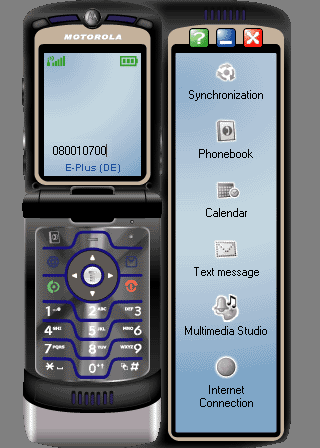
Main window of Motorola Phone Tools. With some approximations, you can work with the program in the same way as with a real V3i phone.
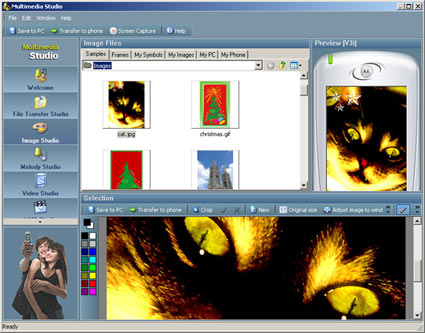
To prepare and transfer photos to your phone, use Multimedia Studio. The illustrations show photo processing ...
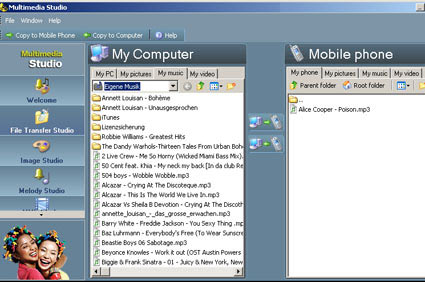
... and file browser. The phone display displays an MP3 file.
Synchronization
You can synchronize your Outlook contacts and calendar with your phone. You can write SMS to a PC and send them to the recipients of the phone book (paragraph "Text message"). The "Multimedia studio" option allows you to view media files (music, photos, MP4 movies) that you want to upload to V3i. You can transfer individual files to your phone (calls, wallpapers, etc.), as well as change the information already contained.
Using the item "Internet connection" you can use the V3i GPRS modem on your PC. But remember that you will pay for traffic. And the ability to type a telephone keypad with mouse clicks seemed useless to us.
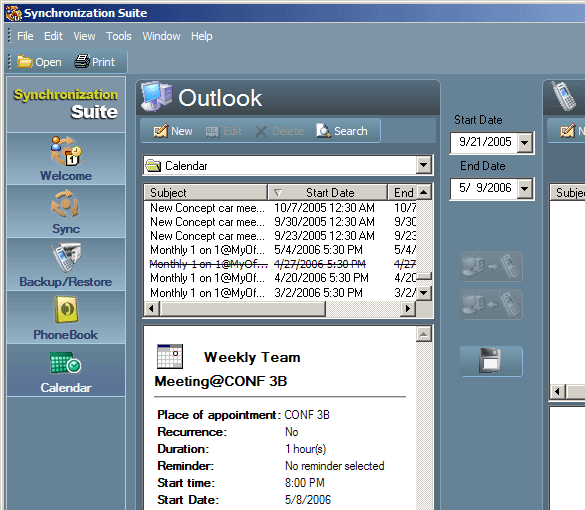
Calendar Sync.
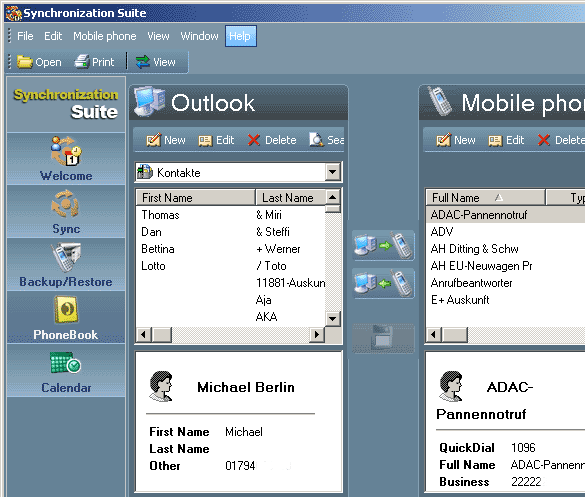
Contact Sync.
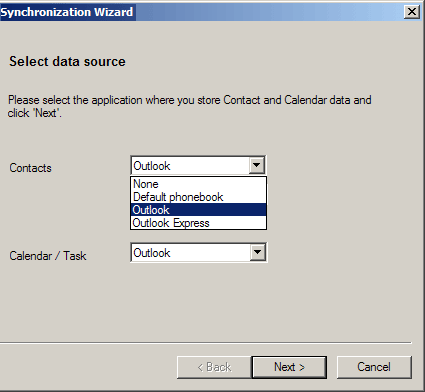
Sync options: from a small list of programs we chose Outlook.
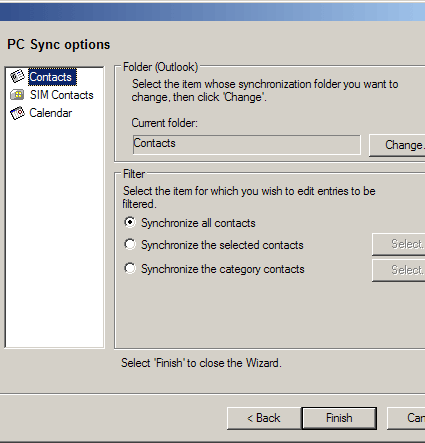
Which item will be synchronized? You can select several options.
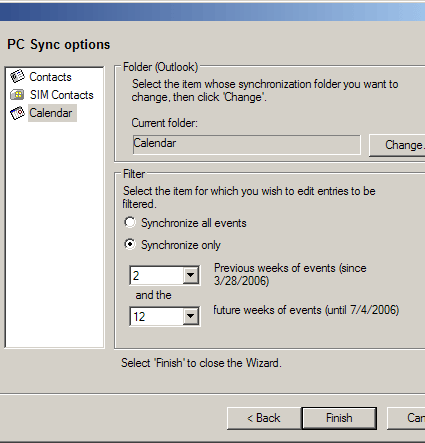
How long should the calendar sync?
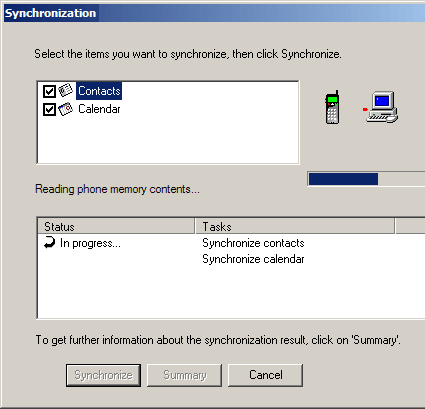
Synchronization in progress. Everything is pretty fast, because you only need to synchronize your contacts and calendar.
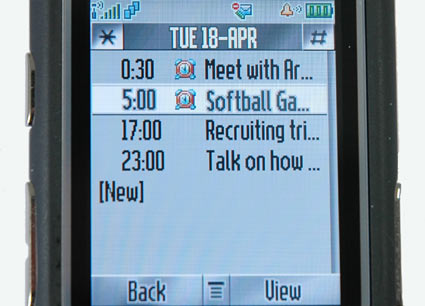
All is ready! Data is synchronized with the RAZR V3i.
Siemens has worked hard to create its own line of phones, which is now sold to BenQ. We do not know what change this will lead to in the product line or in the software. Some phone models, the same S65 and S75, are very popular. And their owners probably will not want to part with their favorites. We decided to choose a S65 phone with 11 MB of internal memory. It also uses an optional RS-MMC slot.
Siemens offers its own software version for each phone model. First, we installed a very simple version of 3.04.40. But then, upon learning that software new models backward compatible with old ones, we installed current version Mobile Phone Manager (v4.05.51), which can be downloaded from the Siemens website. This package works much better with Bluetooth.
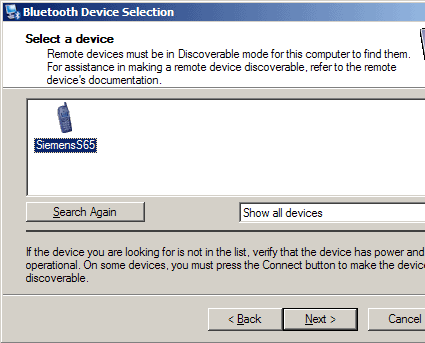
To synchronize the Siemens S65, we used Wildcomm drivers. As with the Windows Bluetooth stack, add a new device ...
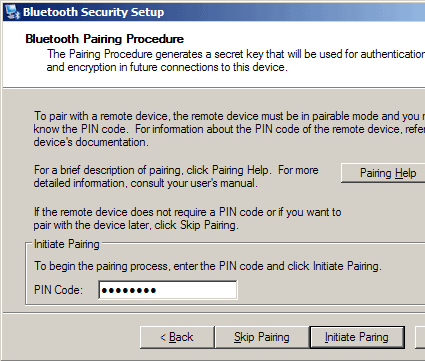
... and complete the connection by entering the password on the cell-phone.
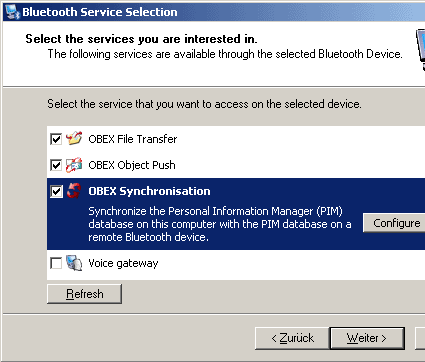
Wildcomm drivers offer a wide range of configuration settings. It is important that the required services are activated.
As with most other packages, Siemens software integrates itself with Windows Explorer. Thus, you can easily manage your phone data. As you can see, Siemens displays phone memory and flash card in different directories.
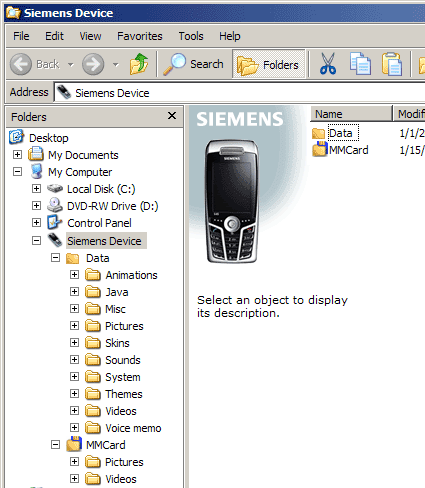
Siemens S65 is integrated into Windows Explorer.
Outlook synchronization in detail
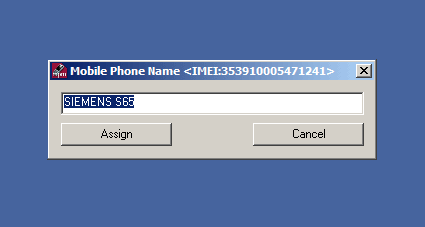
After starting the program, Mobile Phone Manager asks for the name of the phone to which it will connect.
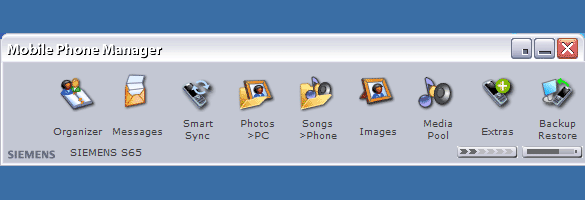
Then the main window of the Siemens program opens. At the bottom you can see the status of the battery and reception.
We were immediately interested in the Smart Sync utility, which can be launched separately from the base program. Separate customizable shortcuts allow you to manage your music and photos. The "Organizer" item provides access to the organizer, tasks, calendar, as well as to the memory of voice messages. The "Messages" item allows typing on SMS on the keyboard. The "Backup / Restore" function allows you to easily copy all the data to your computer, as well as restore data from the computer to the phone.
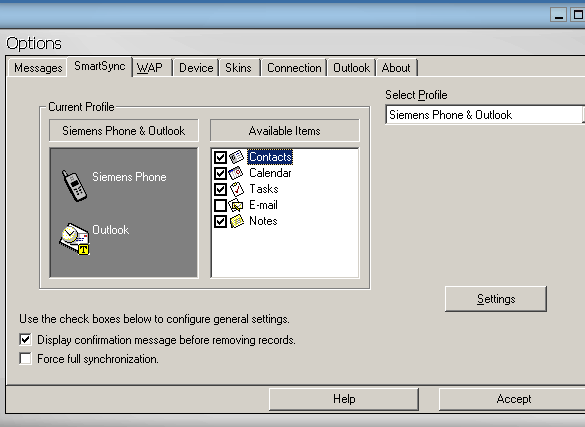
In the settings you can specify the data that will be synchronized with the phone.
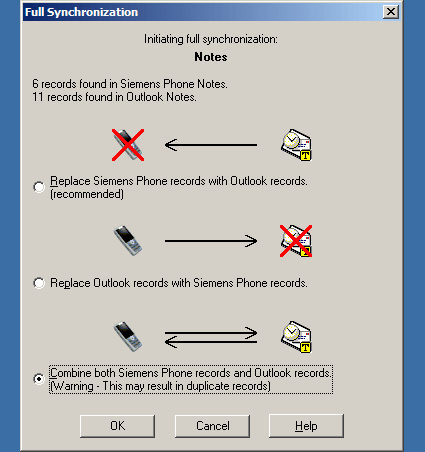
Synchronization is safe: you can select the desired mode. That is, replace the data on the phone, replace the data in Outlook, and also select the data merge mode. Similar modes should be specified for all data (contacts, notes, etc.).
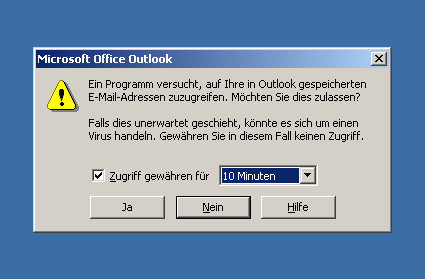
Outlook asks for confirmation of access to the database.
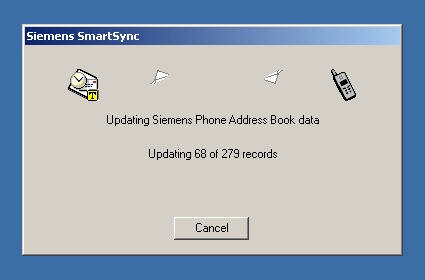
If there is a lot of data (in our MS Outlook there are more than 1000 entries), then the whole process can take a lot of time.
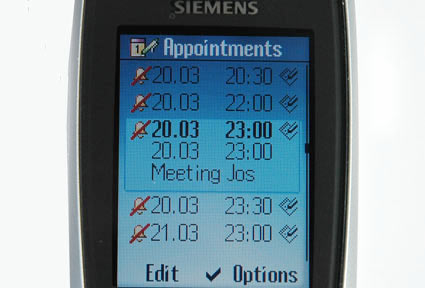
Sync done! Part 1: view events.
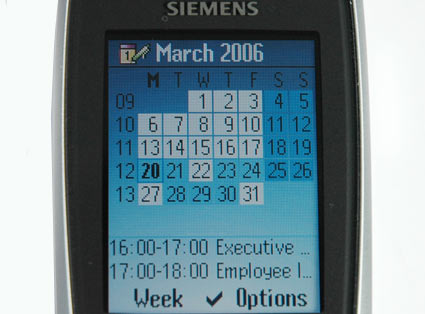
Part 2: view in calendar mode.
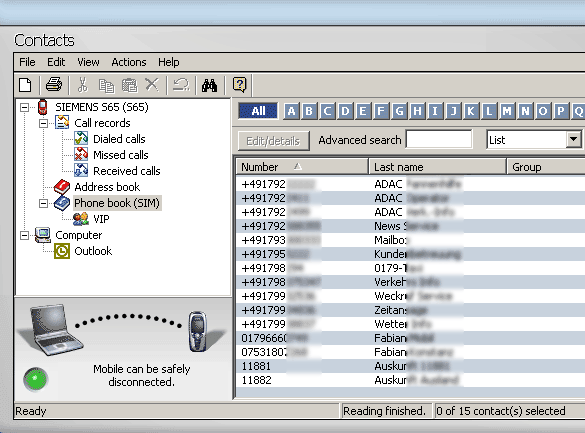
All contacts have been successfully transferred to the phone. The result is easy to check on a computer.
Sony Ericsson The K700i is a good example of a popular multi-functional business phone. It is equipped with 40 MB of memory and a very good display. In general, the phone is able to accommodate a decent amount of data. The package includes the Sony Ericsson PC Suite, which runs on Windows 2000 and XP. It is compatible with the latest versions of Outlook and Outlook Express.
Unfortunately, the installation takes too much time. In addition, the components are installed without any status confirmations. The user is completely eliminated from the installation process, with the exception of the items that appear in the Start menu and on the taskbar. Until the installation is complete, you still won’t know that the Sony Ericsson PC Suite consists of the utilities SyncStation, File Manager, Mobile Networking Wizard, Sound & Image editor and Mobile Phone Manager.
But further complaints arose. At first, Sony Ericsson was unable to identify the K700i. By calling support, we found out that the Windows Bluetooth stack (it appeared with the release of Service Pack 2) paired with older drivers prevents the Sony program from working properly. Sony decided not to bother with software updates and sent us to the German magazine "c" t ", which describes the solution to the Windows Bluetooth stack problem. We had to turn on the disabled COM ports, after which the phone was recognized.
Note for IR users: the phone does not support high bit rate, so it should be limited to 115200 bps in the control panel ("configuration\u003e wireless connection\u003e hardware").
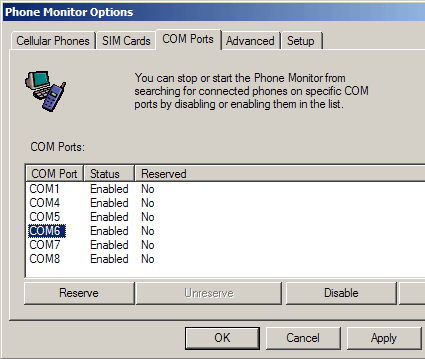
During installation, you must specify the COM ports that will be used for communication. Remember to activate the ports in Phone Monitor.
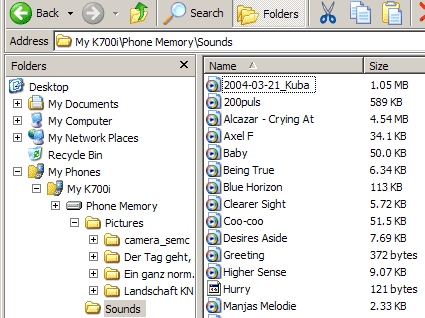
Phone memory can be freely viewed in Windows Explorer and manually transfer files
During the first synchronization, you should indicate where to get the data: from the phone or from the computer. The setting allows you to copy phone data to a computer and vice versa.
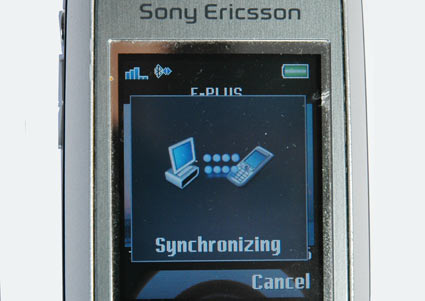
Synchronization started.
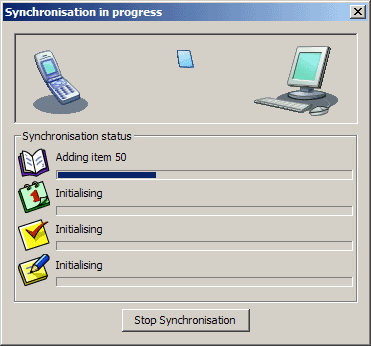
The program shows which items are currently being synchronized. It also alerts you to conflicts.
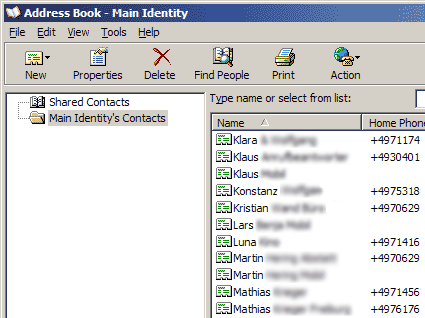
Everything went well. Computer data and mobile phone synchronized.
The Nokia 6230 and the new 6230i are very popular today. In the MMC slot, you can install memory cards up to 2 GB. The display on the 6230 is not very good, but on the 6230i it was refined, as a result of which the resolution increased to 208x208 pixels.
We tested Nokia PC Suite version 6.70.22, which we downloaded on the Nokia website. Immediately after a successful installation, two icons appeared in the taskbar: the first to synchronize and the second to display the connection status. The second icon provides access to all package utilities. Unlike previous versions, synchronization now works more reliably. The program supports synchronization with MS Outlook, Outlook Express, Lotus and and Lotus Organizer.
It took 1 minute 23 seconds to transfer a 4 MB MP3 file via Bluetooth to a Nokia phone, which corresponds to a speed of 46 kB / s. So that nokia phone The 6230 was the fastest model in our testing. 6230 does not understand MS Office documents, but can display text and photos.
Clicking on the Nokia PC Suite icon launches the corresponding program. And, for example, the "Contacts" icon opens a new Explorer window where you can see the list of contacts.
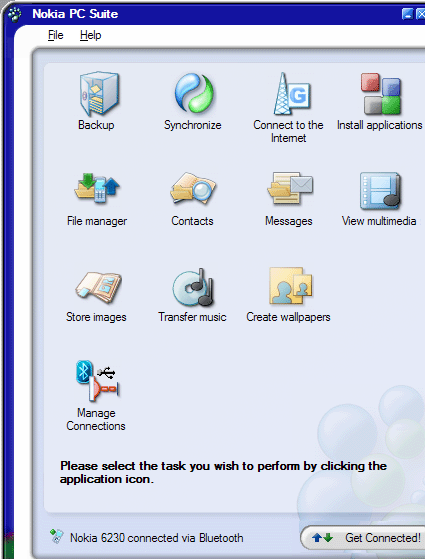
Synchronization settings, part 1. Using the "Settings / Create new settings" item, you can select the program with which synchronization will be performed. You cannot set profiles for multiple users.
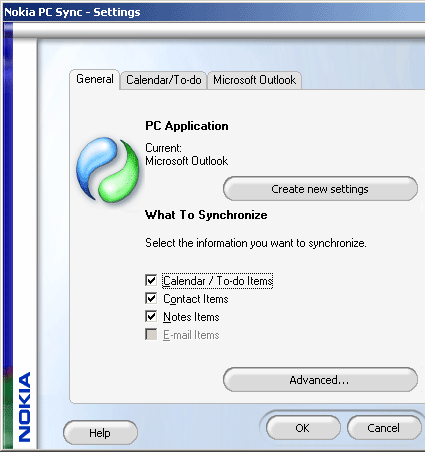
Synchronization settings, part 2. You should select the data that you plan to synchronize.
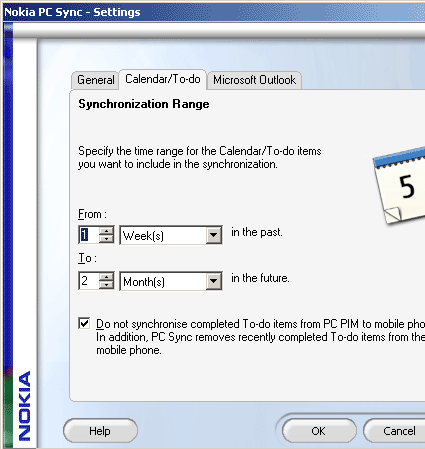
Synchronization settings, part 3. You must specify the time period for which the calendar will be synchronized. On the third tab, "Microsoft Outlook", you can set the path to the mailboxes.

Synchronization works smoothly and without problems. You can also set scheduled synchronization.

The Nokia phone received all the data without error. So on the phone looks like a calendar after synchronization.
The Samsung SGH-D600 phone is pleasantly distinguished by just a fabulous display with a high resolution of 240x320. The phone has a built-in 76 MB of memory, it supports several formats of office documents, and is also equipped with a tiny TransFlash (SD micro) slot. SGH-D600 allows you to perform different kinds synchronize or transfer files. Samsung included a USB cable in the package, so you can get started right away. If you prefer Bluetooth, you should buy a USB-stick Bluetooth, or get a laptop with a built-in Bluetooth-controller. The phone does not have an infrared interface.
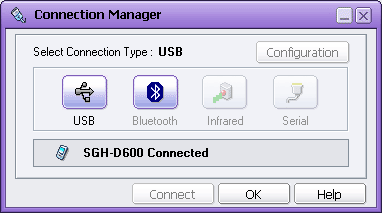
Connection window Samsung PC Studio. Depending on the phone and computer, you can choose different options.
It took 1 minute 51 seconds to transfer a 4 MB music file via Bluetooth, which gives a very fast speed of 36 kB / s. The speed is not a record, but still three times faster than the Motorola RAZR.
The phone accepts large files without any problems. The built-in Picsel Viewer utility allowed you to view MS Word, PowerPoint, and Acrobat documents on the SGH-D600. Of course, most of the time you have to increase the text or scroll it, but all the graphics and text are displayed in full.
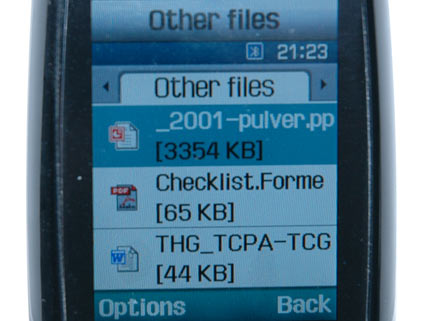
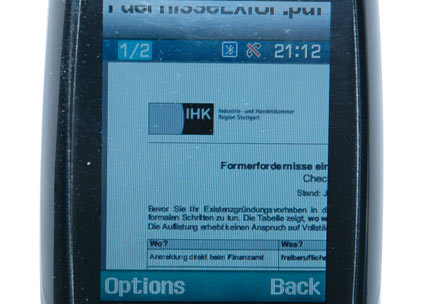
The smallest PDF viewer in the world?
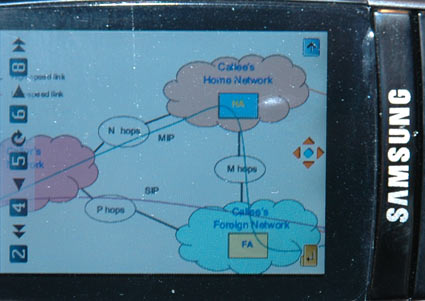
You can view a PowerPoint presentation.
Serious synchronization program
After installing Samsung Software PC Studio 3.0 and drivers, we decided to check the cable connection with Phone Explorer. For some reason, this type of connection worked twice as slow as Bluetooth.
After we did a few syncs via Bluetooth with other devices, samsung program Studio refused to establish a Bluetooth connection with the phone. Moreover, the Windows Bluetooth stack continued to work normally. As we suspect, several synchronization programs could not share the COM ports of our test laptop, but on computers ordinary users everything should go fine, since it usually uses one synchronization program.
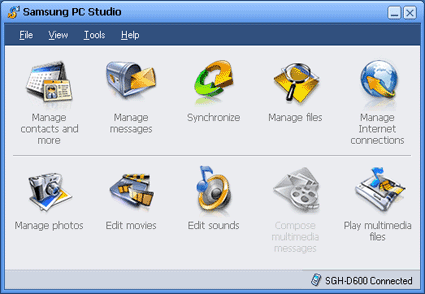
The main window of Samsung PC Studio.
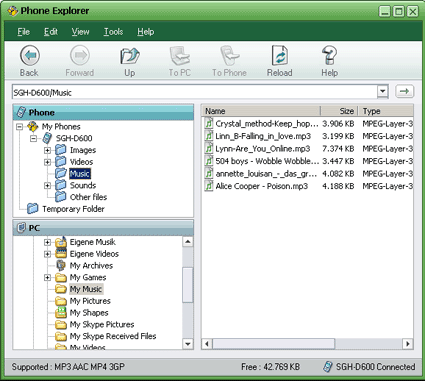
Using Phone Explorer, you can easily deal with files on your phone.
The software package covers almost all the functions of a mobile phone. You can manage your Outlook contacts and appointments, and add various information, for example, in .vcf or .csv files from MS Excel. Using the "Manage messages" item, you can write SMS on a computer or copy existing SMS to a computer. The synchronization key starts the corresponding process with the phone.
If you click on "Manage files", a file manager will be launched, allowing you to copy music, documents or other files to a computer or phone. The package is completed by a program for processing music, photos and videos, as well as a multimedia player. In addition, the phone can be used as a modem.
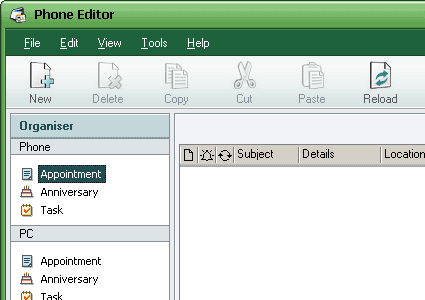
We decided to transfer Outlook information to the phone. In the main window, we selected the appropriate utility Manage contacts and more. Then they were able to import and work with contacts and tasks. If any necessary data is present on the computer (bottom left), but it is not on the phone, then you can simply import everything.
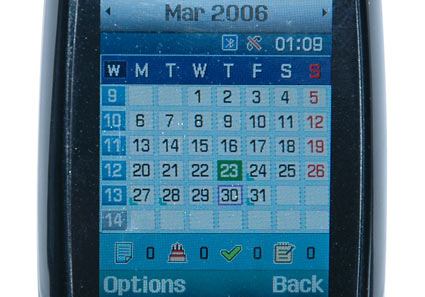
Calendar on the SGH-D600.
Microsoft has long been trying to break into the mobile sector. After the company released the more or less successful shell of Windows CE, a considerable number of PDAs switched to Windows Mobile. Works on some smart backgrounds windows system Mobile 2003, as on our Motorola MPX 220.
Microsoft Active Sync has been developed for mobile devices Windows Using Active Sync and Windows Explorer, you can view the contents of a mobile device in new branch Explorer called "Mobile device".
On Microsoft, you can download the latest version of Active Sync 4.1. PDAs with Active Sync usually use a dock for synchronization. First, we will try to establish an IR connection, since it is also based on a serial port. Bluetooth and USB options are available.
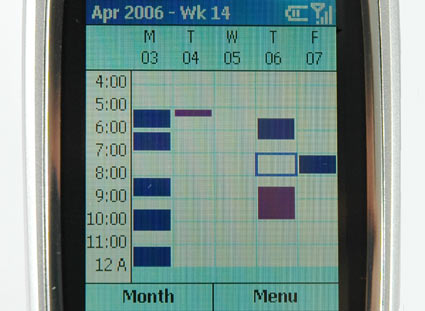
Synchronized weekly calendar ...
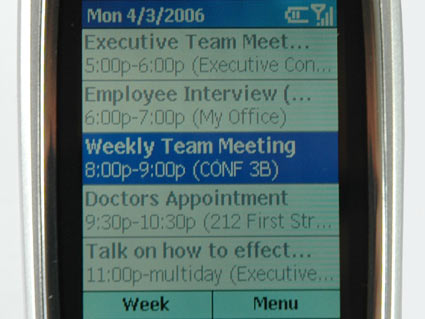
... and a list of synchronized contacts.
Apple iSync Sync Utility supports a wide range of sync options. Initially, Apple wanted to provide iPod users with a service to copy the address book to their iPod. Today, the program not only knows how to synchronize iCal events (calendar), but also supports about 60 different mobile devices: mobile phones, iPods and some PDAs. Some third-party software vendors offer programs, such as The Missing Sync from Mark / Space, that provide device compatibility. Microsoft has developed an update for Mac Office 2004 users that allows you to synchronize Entourage data through iSync.
Apple's own list is also constantly updated. The latest OS X.4.6 update added new devices to the list, the same Nokia 6230 and Motorola RAZR V3i. A list of compatible devices can be found at next page .
If you need finer control over synchronization, you can use the Apple .mac Sync program. It allows you to transfer data to other devices, including over the Internet.
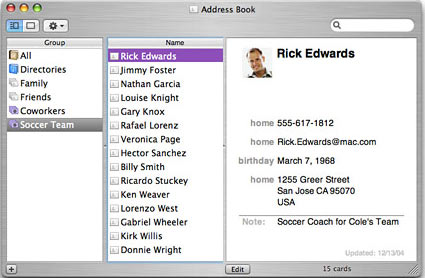
Mac OS X Address Book Contacts
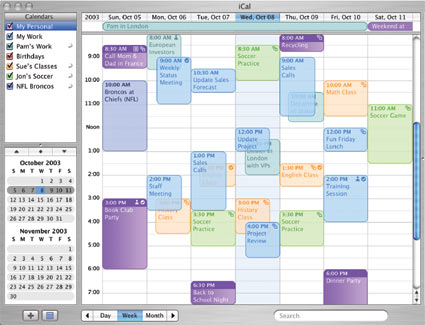
ICal Calendar
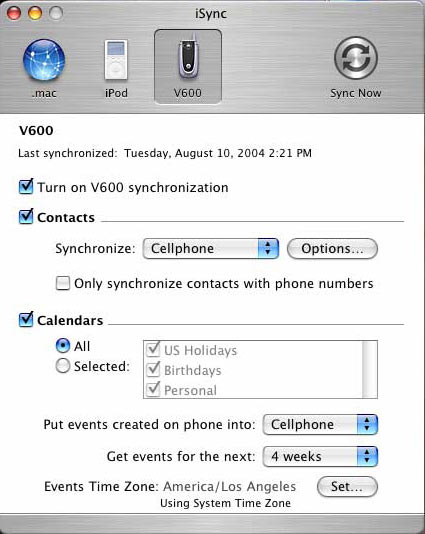
All this data can be quickly synchronized with external devices using iSync. But the device must be supported by the program (see the Apple website).
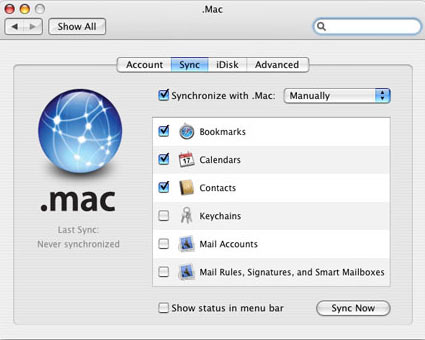
.mac Sync also allows you to synchronize over the Internet.
Conclusion: make sure the data is in sync
Motorola, Nokia, Samsung, Siemens, Sony, Microsoft and Apple all use their own data synchronization solutions. In our testing, all synchronization and data transfer programs for cell phones and mobile devices have successfully shown themselves. Each solution allows you to synchronize your calendar and address book with Outlook or Outlook Express. Some programs provide more options than others, and problems sometimes also arise.
But before synchronization, you should choose the appropriate connection. The Bluetooth wireless protocol provides maximum flexibility, and is supported by all decent phone models. But due to the relatively slow speed, we recommend using Bluetooth for synchronization, and transferring large amounts of data in another way. You can also connect the phone to the computer using a cable. But we still do not recommend buying a cable: it is much better to invest in a USB Bluetooth adapter, which can be used for other purposes. Yes, and buying a new cable every time when changing the phone is also not the best option.
We recommend backing up your mobile phone data at least once every three months. Or more often, depending on how often you change your phonebook and calendar. If the data is important, it is best to burn it to a CD or DVD. It takes 15-30 minutes to reserve, which is quite reasonable, considering that you protect the data of your mobile phone from loss or damage.
Remember to turn off the Bluetooth function when synchronization is complete. In addition to saving battery power, this step will protect you from those who want to profit from the data of your phone.
What is contact synchronization and why is it needed? How to save contacts from Android to a computer: step-by-step instructions.
In gadgets operating on the basis of the Android operating system, a function is built-in that allows you to synchronize contacts. However, not many people know about this, and therefore owners of smartphones often encounter such a problem as saving contacts from Android to a computer or other phone. It's no secret that smartphone thefts have become more frequent in recent years. Also, many may simply lose the gadget. Sometimes during unforeseen situations, the phone can be seriously damaged. In such cases, it is difficult to restore all contacts, since almost no one is using a notebook. To avoid such problems, you need to prepare in advance and learn how to save contacts from Android to your computer. Due to the fact that the Android operating system was developed in googleSyncing your contacts is pretty simple. All data is uploaded to the cloud storage, where the user can view and edit it. In addition, access to data can be obtained from any device: smartphone, tablet, computer. This function is useful when changing the gadget, just connect the account in the smartphone google system, and all contacts will be automatically restored.
Syncing contacts in a smartphone is quite simple. The following provides information on how to save contacts from Android to a computer, step by step.
In order for data synchronization to succeed, you must be registered with Google. Then: - Open the “Settings” menu in the smartphone. - Go to the “Accounts and sync” tab. - Click on the item “Add account”. - From the list, select "Add new account»If you need to register with Google. Or “Snap an existing one” if mailbox already registered. - Enter account information. - Exit the “Settings” menu and go to “Contacts”. - Open the settings menu and select the “Import / Export” item. - From the drop-down list, select the place where the data will be copied from: SIM card, phone memory or memory card. - After choosing the location of the contacts, you must mark the account with which the data will be synchronized. - Select the desired contacts and click "Copy."
Contact synchronization completed. It remains to learn how to save contacts from Android to a computer. Now you can view all the contacts transferred to the cloud storage from a computer. To do this, you must log in to Google through any browser. You can view the data in the " Google Contacts", Which is located on the page of the electronic mailbox. Thus, you can not only view all contacts, but also perform several actions. Data can be edited, copied and deleted. The service allows the user to combine the same contacts.
It remains to understand how to save contacts from Android to a computer and vice versa. In the case of a smartphone, just enter the data account, and they will appear in phone book. Copying data to a computer is easy. You need to: - Go to the "Contacts" tab. Select the "Advanced" item. In the menu that appears, click on "Export". - Choose the format in which the data will be saved (vCard, CSV for Outlook and Google CSV). - Click “Export”. Further, the data will be saved on a personal computer.
Today, a mobile gadget is no longer a luxury or a geek's toy, the purpose of which is known only to him, but the same ordinary thing as a TV or microwave. Most of us own not only a smartphone, but also a tablet, laptop, portable game console, and many have smart HDMI sticks for running Android. The problem with all this diversity is that mobile OS does not have the means to synchronize and remotely interact with multiple devices.
Instead of introducing
Google and Apple have done a lot to make using their devices as convenient as possible. A single account for accessing services, transparent data synchronization, cloud storage for settings - these are only part of the functions implemented by software giants that make gadgets extremely convenient to use and save a lot of time.
However, when it comes to synchronizing multiple devices with each other, serious problems arise. None of the OSs just have such functionality. Of course, we can link all devices to a single Google and Apple account, which will allow us to install latest versions software, receive letters, messages and other notifications immediately to all devices. However, about any synchronization of settings, lists installed applications and there is no speech on the memory card, each device is a “thing in itself” that can have access to one storage cloud, but nothing more.
We will not understand why this situation has developed, but instead discuss ways to solve the problem, that is, try to find tools and modifications that would help us configure the synchronization and interaction of various devices. Android devices for various purposes in our latitudes are much more common than iOS, so we will talk about a green robot.
What is what
When we say “synchronization of several devices”, then most often we mean a smartphone and a tablet, these two devices are most popular. However, besides them, there are many other Android devices on the market, including smart TVs, Chinese HDMI dongles that have gained popularity, as well as more exotic things, such as the OUYA game console and the NVIDIA Shield handheld console.
Personally, I have a total of six different Android devices, of which I use three daily and one at least several times a week. This is a smartphone, tablet, game console and HDMI dongle. Devices, as you can see, vary greatly in purpose, functionality, and installed versions Android Therefore, the task of synchronizing and interacting with them was quite non-trivial, it was necessary to ensure common access of all devices to the file storage, synchronize applications between the necessary devices, make a universal remote control from the smartphone, and also raise the DLNA server from which all devices could pull multimedia files.
Application Data
The first thing to do is to organize the synchronization of settings and application data between devices. In fact, this is the main problem that contains the greatest amount pitfalls. The fact is that in Android, synchronizing settings and application data is far from as simple as in classic desktop OSs. If in the same Windows or Linux it is enough to simply copy the files and directories of the application settings to another machine, then here, firstly, we will face the problem of differentiation of rights, which does not allow one application to access the data of another, and secondly, we can get the problem of incompatibility between devices.
Due to the first limitation, synchronization of application settings is possible only if you have root privileges on both devices, because of the second you cannot do without specialized tools that can fix problems if they occur. In total, there are two types of tools that are suitable for us, these are backup applications of the type Titanium backup and Helium, as well as specialized synchronization applications like DataSync and AppSync. The advantage of the former is asynchronous operation: I copied the settings today, restored it to another device tomorrow. The second advantage is the ability to configure time synchronization, for example, every night.
Fortunately, there is a tool that combines the virtues of both approaches. DataSync not only knows how to copy application settings and files on a memory card to any device in the same local area network, but also allows you to backup to Dropbox or Box.com, and as an add-on, it has Bluetooth and NFC support, which will come in handy on the go.
The algorithm for using DataSync is as follows. Install the application on all devices that should participate in synchronization, launch it. Next, on the device that should accept or transfer its settings to another, select the desired applications and files. All of them will be added to the queue (Queue), which can be accessed by sliding the panel below. After that, click on the synchronization icon at the top (two arrows) and select the desired device from the list. Tap on the device will open a dialog for choosing the type of synchronization: on both sides (the option is available only in the paid version), here or there. After selection, the synchronization process will begin.
It goes without saying that running an application each time and turning on synchronization is not the most interesting activity, so DataSync has the ability to configure scheduled synchronization. To do this, just save the queue using the floppy disk icon at the top of the screen, then hold your finger on its name for a long time in the list and select Schedule Queue from the menu. So you get the opportunity to configure selective synchronization necessary applications on different devices.
By the principle of its work, DataSync is a typical backup. He takes the package with the application, then copies all its settings and files and sends it to the remote device. Therefore, it can also be used to: a) actually back up applications, b) install the necessary applications along with settings for a new / flashed device from another device and c) for asynchronous synchronization: one device is saved in Dropbox, the other (others) is restored.
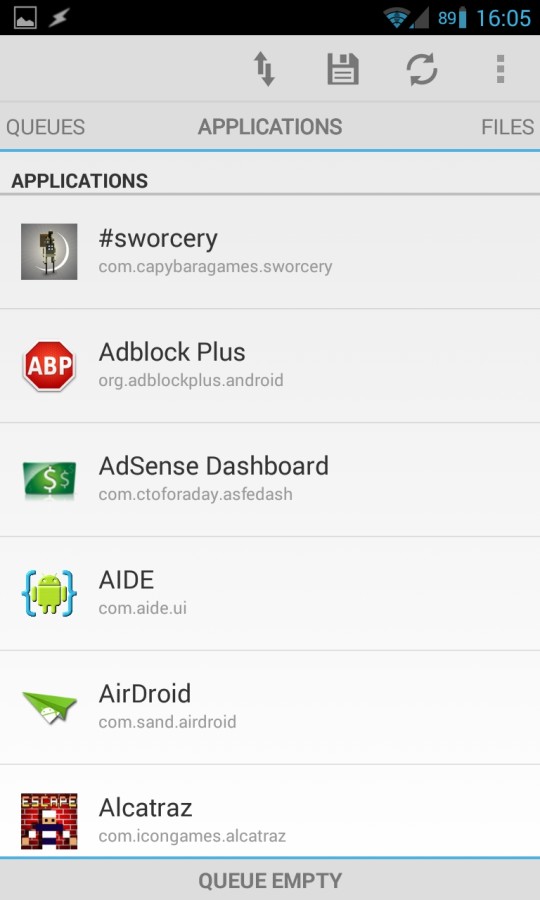
Files
In addition to synchronizing applications, DataSync can be used to exchange files between devices. In the case of rare copying of small amounts of data (books, for example), its capabilities will be quite enough, but if it comes to constant file synchronization in both directions, as well as access to large data stores (home media archive), DataSync will not work.
After many experiments with different synchronization utilities, I came to the conclusion that the most convenient are CifsManager, which allows you to connect SMB disks to any directory on the memory card (visible to all applications), SSHFSAndroid, which connects balls using the SSH protocol, and DropSync, which automatically synchronizes the specified directory with a Dropbox drive.
Mount SMB Ball
To connect the shared Windows folder manually, you need to execute the following sequence of commands:
$ insmod /sdcard/ko/dns_resolver.ko $ insmod /sdcard/ko/md4.ko $ insmod /sdcard/ko/cifs.ko $ insmod /sdcard/ko/nls_utf8.ko $ mount -t cifs -o iocharset \u003d utf8 , username \u003d user, password \u003d password, file_mode \u003d 0777, dir_mode \u003d 0777 // IP / share / sdcard / cifs
INFO
In addition to UPnP / DLNA, XBMC also supports Apple AirPlay streaming technology: "Settings -\u003e Services -\u003e AirPlay -\u003e Allow XBMC to receive AirPlay content."Unlike many other SMB, SSH and Dropbox clients that can be found in the market, these three applications do not restrict access to the balls only through themselves, but instead mount them to public directories, so you can work with data from any program. CifsManager and SSHFSAndroid can be conveniently used to access the home file storage; we connect a network drive and work with files as if they were local (though the media server will not index them).
DropSync is ideal for synchronizing small amounts of data between different devices and PC: for example, to distribute an e-book to all devices, just download it to a laptop and put it somewhere in ~ / Dropbox / Books, in just a few seconds it will appear on all devices with DropSync installed and configured. And there is no dependence on the local network and the Internet connection as such (synchronization will occur as soon as access to the network appears).
Now about how to set it all up. Let's start with CifsManager. Everything here is very simple and complicated at the same time. On the one hand, just start the application, click the "Add New Share ..." button and in the window that opens, drive the server address in the format IP / name-balls, specify the user name: password and mount point, for example / sdcard / cifs, creating a directory in advance. Then we click on the configured ball, and it is mounted.
But this is only a theory; in practice, everything is somewhat more complicated. In fact, CifsManager is just a shell to run something like this:
$ mount -t cifs -o username \u003d user, password \u003d password, file_mode \u003d 0777, dir_mode \u003d 0777 // IP / ballname / sdcard / cifs
However, it will work only if the cifs.ko module is embedded in the kernel, or it can be found at /system/lib/cifs.ko. If this is not so, file system It will not be connected, but “not so” is on so many smartphones. What to do if there is no module? There are two options: either flash the kernel with cifs support, or find / compile a module suitable for your kernel.
We already had a whole article on how to choose and flash kernels, so let's focus on the second option. In total, in addition to the cifs.ko module, for new versions of Android we will also need the md4.ko, dns modules resolver.ko, as well as optional nlsutf8.ko, if there are files with Russian names in the ball. In this case, all modules must be compiled specifically for the version of the Linux kernel that is flashed into the device. It’s far from being possible to find them for every device, but it’s worth trying using search queries like galaxy s3 cifs.ko. Usually, all the necessary modules are packed in one zip archive, which is enough to deploy and copy to a memory card. Next, go to the CifsManager settings, put a checkmark in front of the Load vid insmod option, and in the Path to cifs.ko field list the paths to all modules via a colon, for example: “/sdcard/md4.ko:/sdcard/dns resolver.ko: / sdcard / nlsutf8.ko: /sdcard/cifs.ko ". After that, the program should start mounting the balls normally.
If, however, such perversions for the sake of being able to access the ball do not please you at all, then I would like to draw attention to SSHFSAndroid, which allows you to mount remote filesystems using the SSH protocol. In fact, this is just a wrapper around the well-known sshfs user space file system, using the FUSE Linux kernel module included in all stock kernels starting with Android version 2.2 (using FUSE in Android, the applications and virtual memory cards installed on the memory card are mounted).
Using SSHFSAndroid is quite simple. After starting, the main application window will be empty, except for the “+” and “Settings” buttons at the top of the window. To connect a new file system, press the + button and fill in all the fields of the menu displayed on the screen: Name - an arbitrary name, Host - IP or host name (for example, 192.168.0.100), Remote path - path to the directory on the remote side (for example , / home / vasya), Mount point - mount point (/ sdcard / share), Username - user name and Password - password, respectively. Next, click the "Save" button (the icon in the form of a diskette) and, returning to main screen, just click on the item with the name of the connection. After requesting root rights, the file system will be mounted to the specified directory, which you can work with using any file manager.
Now about DropSync. In fact, this application performs the same task as the desktop version of Dropbox: it allows you to store files on a USB flash drive, periodically synchronizing them with cloud storage. Synchronization occurs only in relation to changed files, and directories for synchronization can be selected individually, sending and receiving from the cloud only what is really needed on a smartphone, without having to download a few gigabytes.
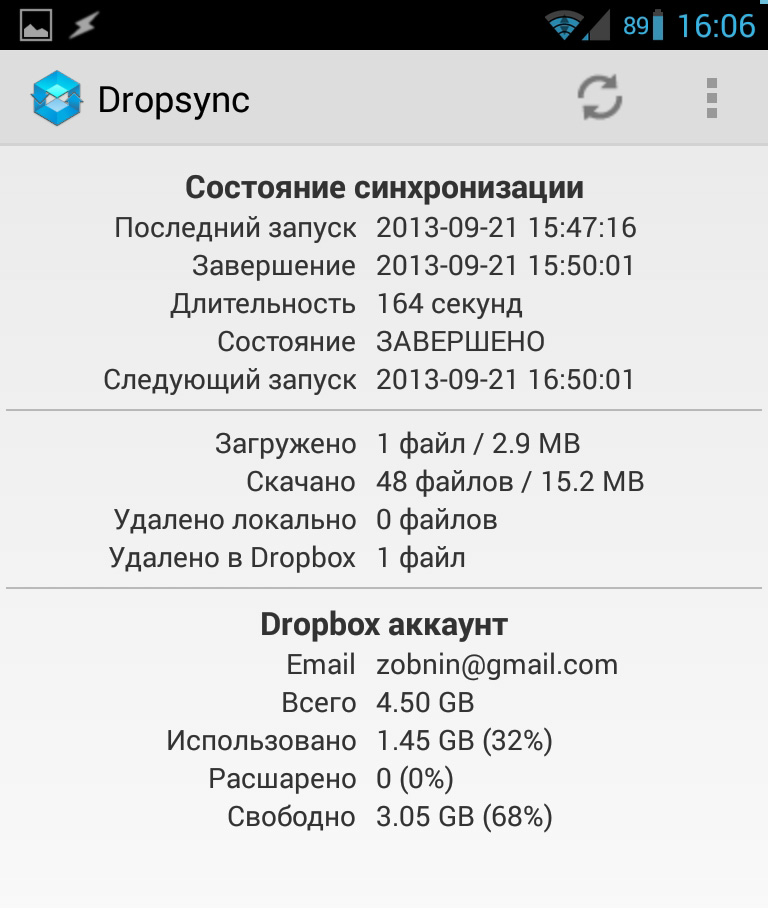
DropSync is very easy to use, you just need to select the directory for synchronization, the directory in Dropbox and the synchronization method: one way or both. After that, the software will hang in the background and will periodically copy changes in files to the Dropbox disk and vice versa. I immediately recommend purchasing the Pro version, it implements Linux support for inotify technology for instant synchronization immediately after changing files, and also removes the limitation on the file size of 5 MB and one synchronized directory.
UPnP / DLNA
The main problem with all of the above file sharing methods is the need get root, settings and even installation of different modules. In the XXI century, when smartphones almost make you coffee, it looks somewhat archaic. Some time ago, UPnP (Universal Plug and Play) technology was invented, which allows you to connect all available "smart" devices to a common network with the ability to access various functions. Unfortunately, software developers and operating systems underestimated the capabilities of UPnP, and today the technology is mainly used only for the exchange and remote playback of multimedia files as part of DLNA technology, which has become the ideological successor and extension of UPnP. These two technologies (often referred to as a single technology stack) are used today everywhere, including different media players and televisions. IN Android support UPnP / DLNA as such is not, but it can be found in a large number multimedia applications, as well as specialized software such as BubbleUPnP and torrent clients.
Basically, the UPnP / DLNA stack is based on the classic client-server interaction model, in which the server acts as a multimedia content distributor, and the client receives and loses it. The difference from other technologies is only that each device here is often universal, acting as both a server and a client, and it can also be a controller that controls the rest of the devices and allows you to determine what, where and where will be played (although it all depends on the implementation, of course).
Such an architecture, combined with the automatic integration of devices into a network, allows for the implementation of a wide variety of device interaction schemes. In our case, we can literally make a few tapes so that the movie stored in the tablet’s memory starts playing on the HDMI dongle using a smartphone as a remote control. And in a few tapes - so that the music from the dongle plays on the smartphone.
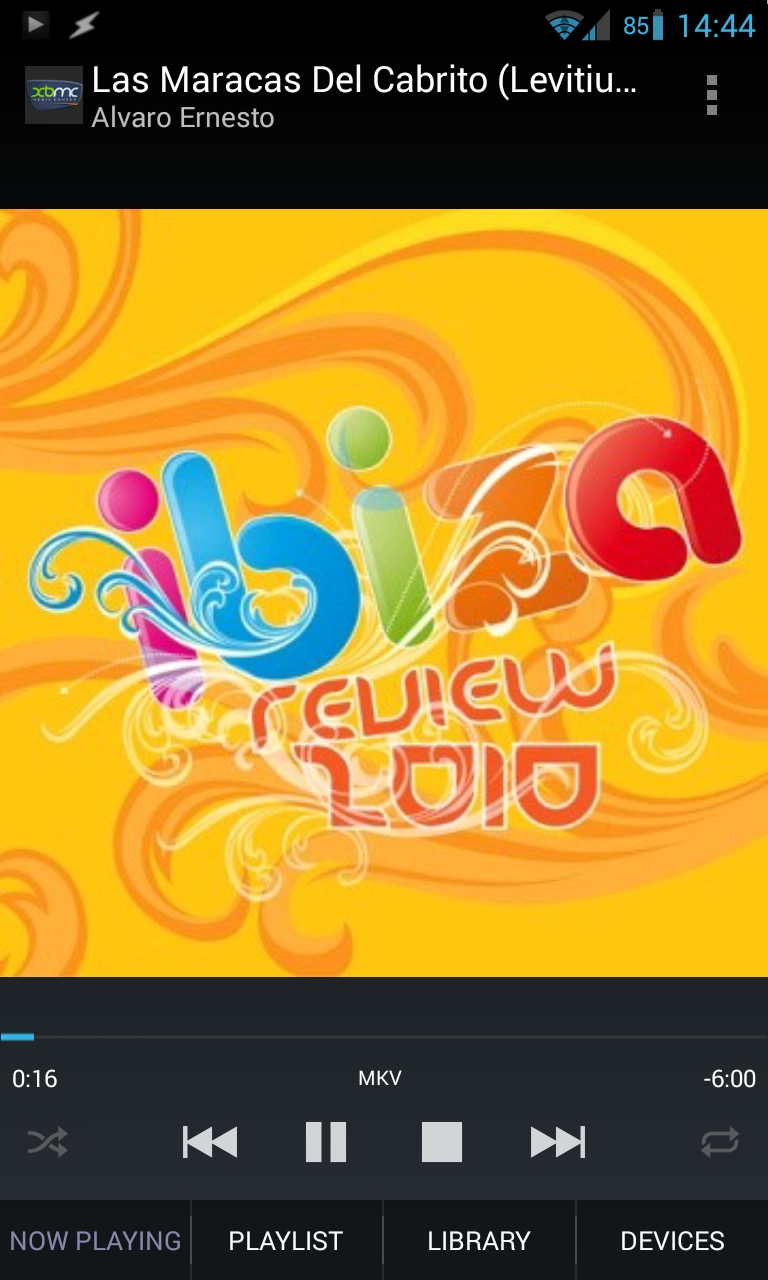
There are three main Android applications that support UPnP / DLNA. These are VPlayer (via VPlayer uPnP DLNA Plugin), XBMC and BubbleUPnP. The first allows you to play content from a DLNA server, the second allows you to distribute and play, and the third is an all-in-one combine that plays, distributes and manages other clients and servers. Built-in support for client DLNA is also available in HDMI dongles based on Rockchip 3066 and Rockchip 3166 chips (this is almost any modern dongle).
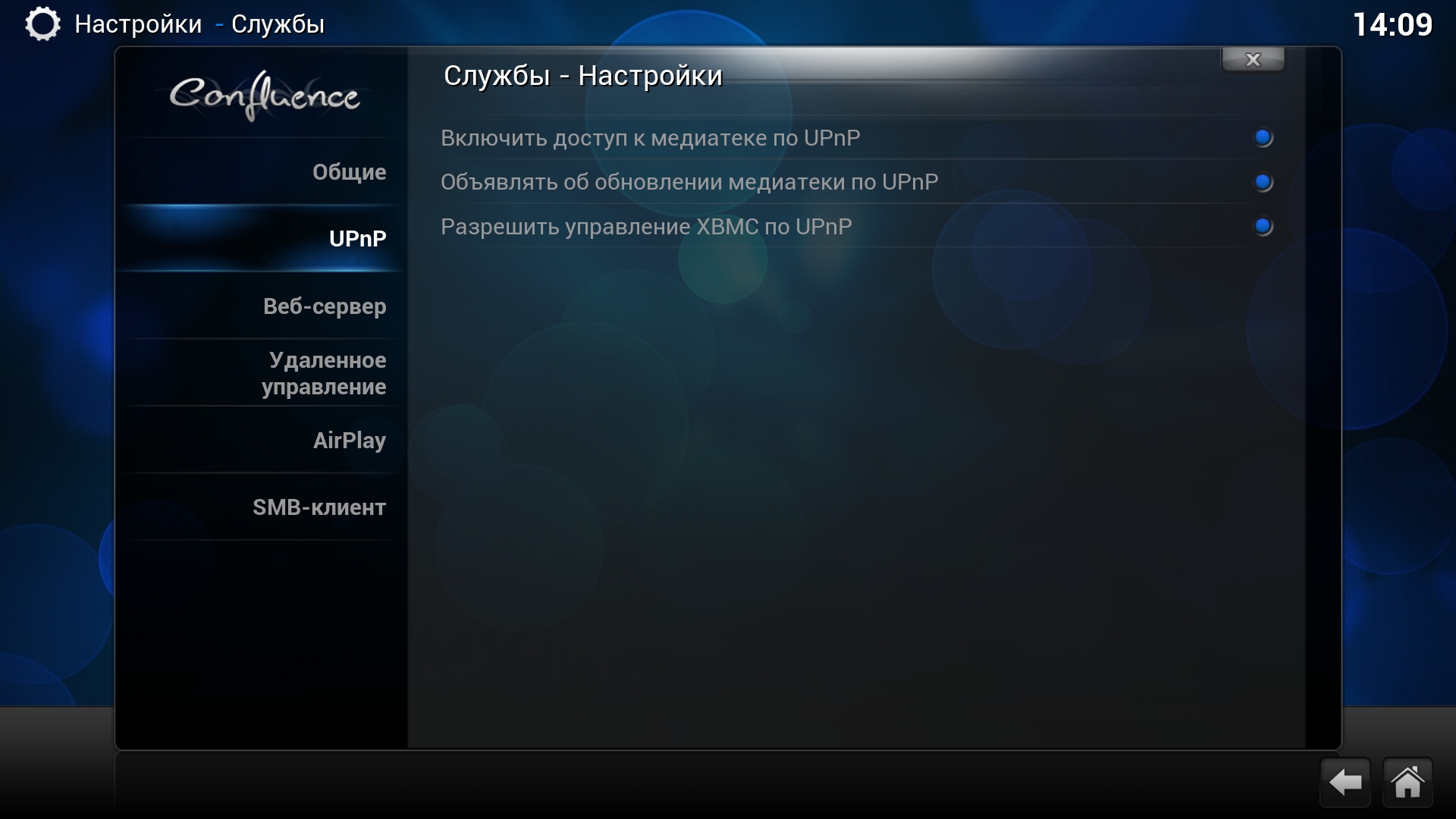
In my home configurationincluding an OUYA TV set-top box with connected hard driveas well as an HDMI dongle, a phone and a tablet, the following applications are used: on OUYA, which, in addition to playing media content on a TV, is also responsible for storing all multimedia data, XBMC is installed, in the settings of which all DLNA operating modes are enabled (Services -\u003e UPnP - \u003e All options). BubbleUPnP is installed on the phone and tablet, the HDMI stick comes with the built-in DLNA client.
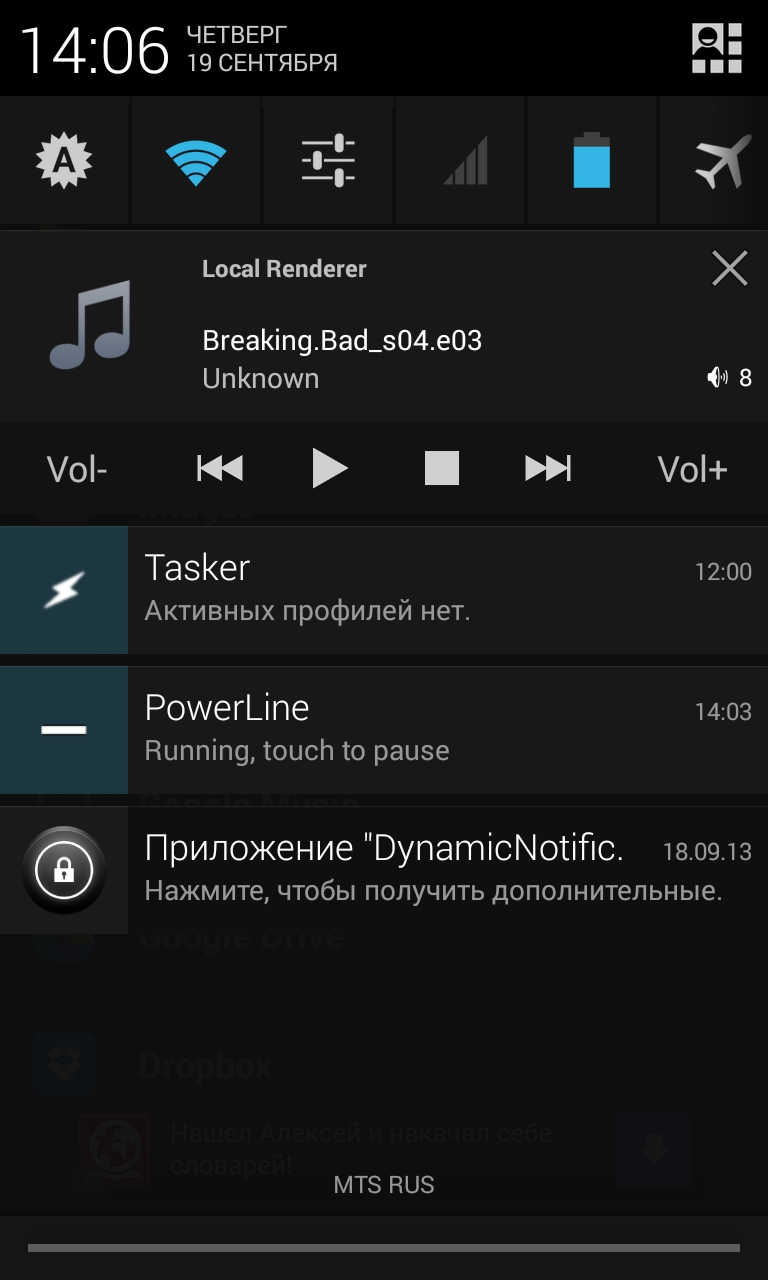
In order to play this or that media file on any device, now just start BubbleUPnP, select the device for displaying content (RENDERERS) on the Devices tab, select XBMC as the content distributor - and that’s all. Next you find desired file in the library (tab "LIBRARY") and tap on it. At any time, I can change the device to display or distribute content, and playback will continue on it. No settings, no IP addresses and port numbers.
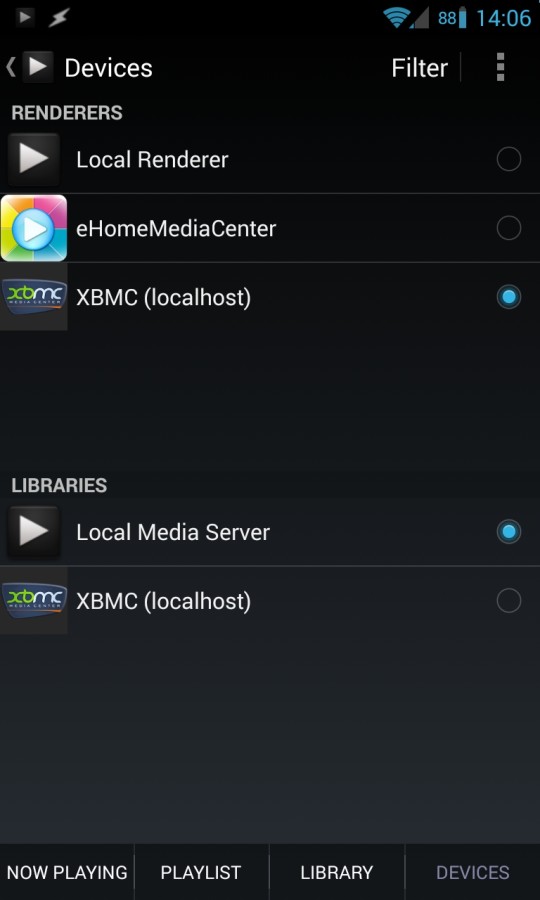
Chromecast
DLNA is a great technology, but it is not designed to stream streams from the Internet. In other words, if we want to watch the video on YouTube, we will have to launch the site client on the device itself, although it would be much more convenient to select the desired video on the smartphone and then automatically launch it on the TV.
INFO
Chromecast streaming support is available in the YouTube for Google TV app. To activate, select the menu item Pair with mobile device and follow the instructions.Especially for such purposes, Google invented an analogue of Apple AirPlay, called Chromecast. Officially, this technology is supported only by the HDMI-dongle of the same name produced by Google itself, but the protocol turned out to be so simple that very soon the enthusiasts took it apart and created an alternative implementation as part of the CheapCast application.
Now, to turn any Android device into Chromecast, just install the CheapCast application from the market on it, launch it and click the start button at the top of the screen. After that, a rectangle button with a Wi-Fi logo in the corner will automatically appear in all Chromecast-enabled applications. We click on the button, select the device, and the video is played on it.
The only problem is that only YouTube and the built-in media player currently support Chromecast streaming, but Google promised to add support for PLay Movies, Netflix and several others. Kush from the CyanogenMod team worked on the ability to stream from any application, but Google quickly turned this development off by disabling the ability to stream to any third-party applications.
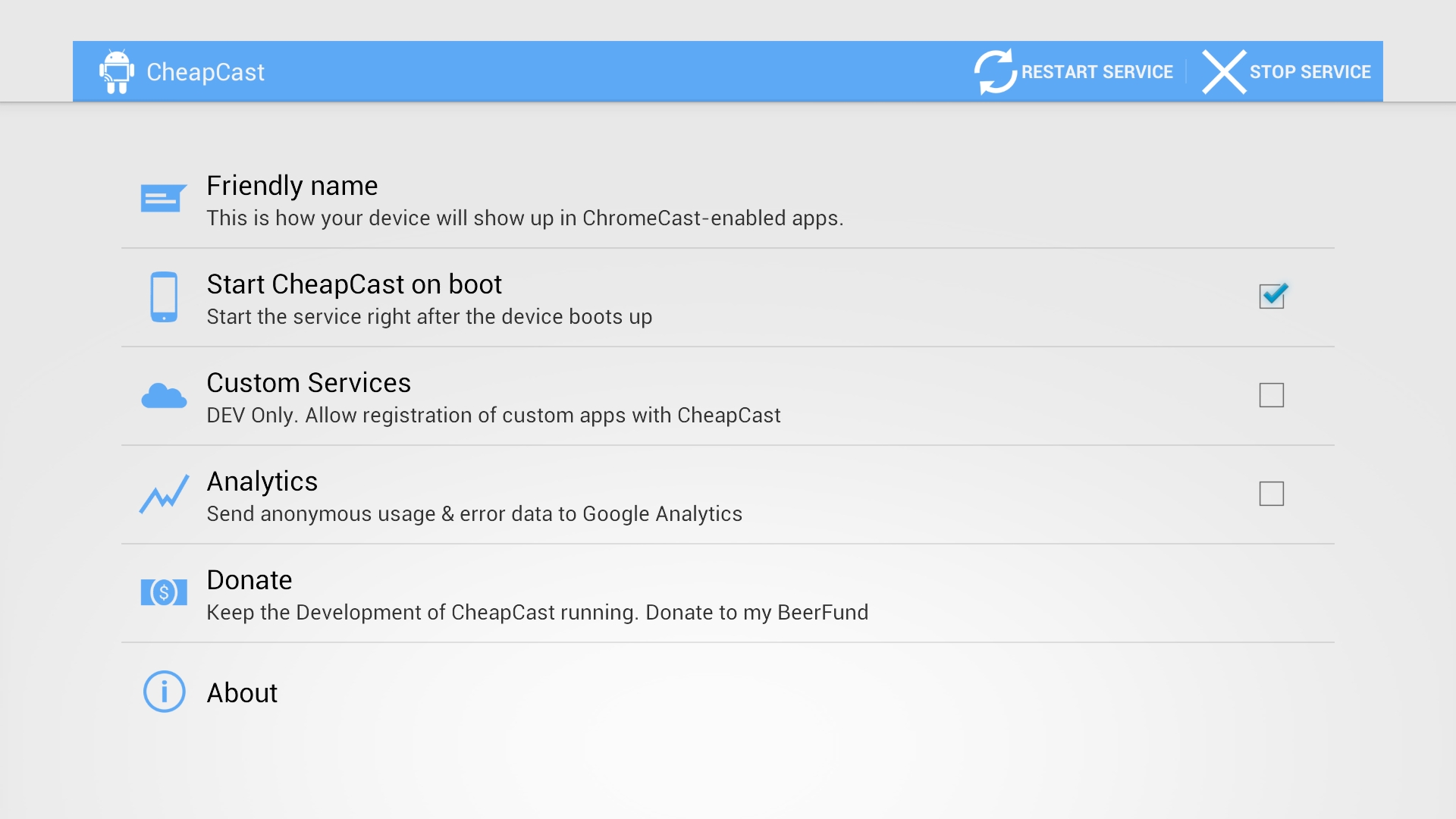
Remote / Joystick
To control different TV set-top boxes, HDMI sticks, and in some cases a tablet, you need a “remote” remote control. I do not suggest buying special Bluetooth remotes or equipping devices with infrared receivers, instead we turn the smartphone into a remote. Of the variety of remote control applications that can be found in Google play, the only decent option is DroidMote. He has a free client, but he will have to pay 80 rubles for a server for an Android device.
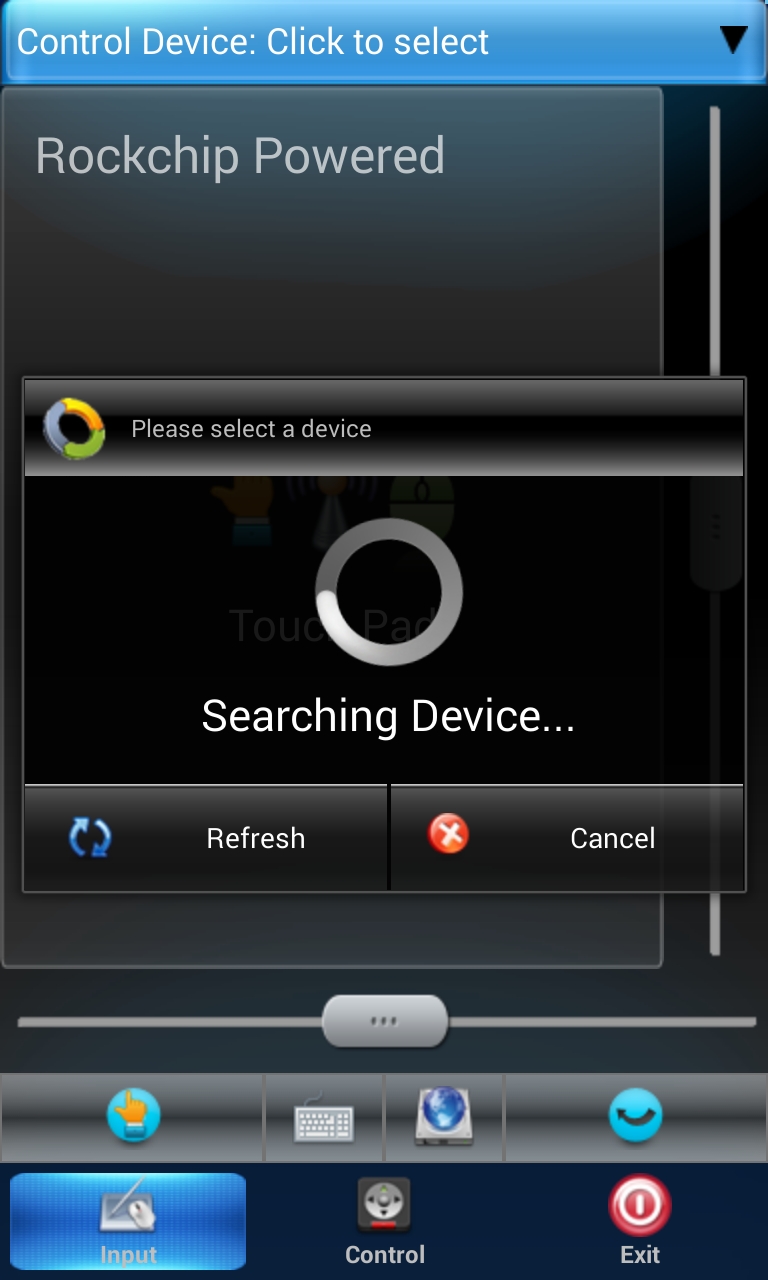
The client and server find each other and connect to auto mode, so you don’t have to configure anything. From the management tools available: touchpad, keyboard, multimedia remote and joystick. The latter, by the way, is especially interesting in that it allows you to create mapping of keys to points on the screen of a managed device, so that with it you can play absolutely any game, even if they do not support the joystick.
INFO
SSHFSAndroid does not work in Android 4.2, however, the author promises to fix the problem in the near future.Server functionality is available only in the paid version of BubbleUPnP, costing 140 rubles.
To share the memory card of any gadget, you can use the SambaDroid application. It does not require configuration and starts the Samba server automatically after starting the application.
conclusions
Combining gadgets into one seamlessly working network is not an easy task, and the techniques described in this article are not ideal and will not work for everyone. However, while we have no other tools, we only have to wait for Google itself or the developers of CyanogenMod to add such features to Android. That this will happen, I am 100% sure, the only question is when.




